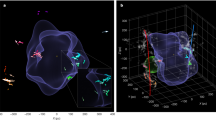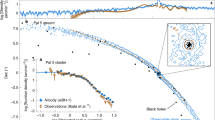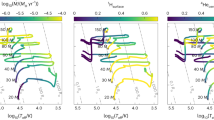Abstract
GALACTIC dark matter may consist of weakly interacting particles which can be captured and trapped in stars1, and which would then contribute to the transfer of energy2,3. A special class of these particles ('cosmions'), with weak cross-sections that are larger than standard has been invoked as a solution of the solar-neutrino problem, and also as a means of suppressing convection in the cores of horizontal-branch stars4. Here we investigate this latter effect numerically and find that the convection breaking in horizoná-tal-branch stars by cosmions, or by any other novel mode of energy transfer, induces thermal relaxation oscillations with a period of ∼5xl05yr, corresponding to the core Kelvin-Helmholtz time-scale. These thermal pulses can be understood analytically in terms of a simple two-zone model. Observationally, the brightness and brightness dispersion of horizontal-branch stars increases, the periods of RR Lyrae stars change over a pulsation timescale, and the duration of central helium burning slightly decreases. None of these effects is in conflict with observations, but, on the contrary, point to a speculative resolution of the age problem for globular clusters and to an alternative explanation of the period fluctuations of RR Lyrae stars.
This is a preview of subscription content, access via your institution
Access options
Subscribe to this journal
Receive 51 print issues and online access
$199.00 per year
only $3.90 per issue
Buy this article
- Purchase on Springer Link
- Instant access to full article PDF
Prices may be subject to local taxes which are calculated during checkout
Similar content being viewed by others
References
Press, W. H. & Spergel, D. N. Astrophys. J. 296, 679–684 (1985).
Steigman, G., Sarazin, C. L., Quintana, H. & Faulkner, J. Astr. J. 83, 1050–1061 (1978).
Spergel, D. N. & Press, W. H. Astrophys. J. 294, 663–673 (1985).
Renzini, A. Astr. Astrophys. 171, 121–122 (1987).
Gilliland, R. L., Faulkner, J., Press, W. H. & Spergel, D. N. Astrophys. J. 306, 703–709 (1986).
Gould, A. & Raffelt, G. Astrophys. J. (in the press).
Goodman, M. W. & Witten, E. Phys. Rev. D31, 3059–3063 (1985).
Buchler, J. R. & Perdang, J. Astrophys. J. 231, 524–533 (1979).
Sweigart, A. V. & Renzini, A. Astr. Astrophys. 71, 66–78 (1979).
Iben, I. Jr & Renzini, A. Phys. Rep. 105, 329–406 (1984).
Winget, D. E. et al. Astrophys. J. 315, L77–L81 (1987).
Author information
Authors and Affiliations
Rights and permissions
About this article
Cite this article
Dearborn, D., Raffelt, G., Salatit, P. et al. Dark matter and the age of globular clusters. Nature 343, 347–348 (1990). https://doi.org/10.1038/343347a0
Received:
Accepted:
Issue Date:
DOI: https://doi.org/10.1038/343347a0
Comments
By submitting a comment you agree to abide by our Terms and Community Guidelines. If you find something abusive or that does not comply with our terms or guidelines please flag it as inappropriate.



